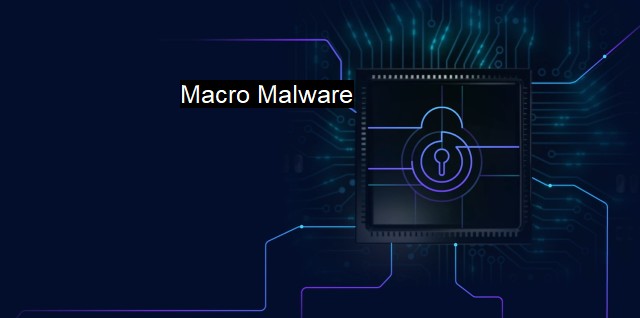What is Macro Malware?
Macro Malware: Understanding the Threat to Antivirus Software and Cybersecurity
Macro malware refers to a type of malicious software coded in the same programming language that's used for software applications. This form of malware is coded using macro commands, hence the name "macro malware". To understand the concept of macro malware, it is essential to know macros priorly. A macro is an automated sequence of designated tasks meant to help service repetitive tasks more swiftly and correctly. While these are often beneficial, when manipulated by hackers, they can be used for malicious intent, leading to the creation of macro malware.In the general context, macro malware is more differential than other forms of malware. It's primarily known for targeting software like Microsoft Office Suite applications, specifically Word and Excel. How it operates is that it inputs itself into the application’s macro—think Word or Excel—uses VBA (Visual Basic Applications) language, then enacts a sequence of operations in the application without the user’s knowledge.
Today, Macro malware remains as one of the preferred methods used by cybercriminals, not just because of its evasion capabilities, but also because of its flexibility and ease of distribution. It is often downloaded through email attachments where it tricks the user into enabling macros which are typically disabled by modern security measures due to this exact reason. As soon as a macro gets enabled, the malware starts running its tasks, leading to numerous potential damages including stealing sensitive data, enabling remote access, or even installing more malware into the device.
Delving deeper, Macro malware shouldn't be mistaken as harmless due to its non-executable delivery technique. Instead, this attribute makes it slightly more assures compared to other malware types, mostly due to modern Word and Excel's heavy utilization across various sectors worldwide. Its non-executable format also often enables it to evade traditional anti-malware software scanners that are usually programmed to detect executable files.
The past few years have also seen a considerable evolution in macro malware. Nowadays, it's no longer limited to infecting Word or Excel files but is frequently seen attacking other relevant software applications too. The new malicious macros also record their activities, send information to outside servers, download other forms of malware, or even control the victim’s computer remotely.
The imperative question that arises is, how to prevent macro malware attacks? Preventing these attacks isn't a one-step process but involves a series of cautionary steps that need to be taken. The users should steer clear of opening any suspicious attachments or links, especially from unfamiliar sources. On a technical level, system administrators, as well as individuals, need to keep all software consistently updated. Old versions of software often have well-known vulnerabilities that malware exploits. Also, organizations can prevent infection by disabling macro content or setting them to be opened only in a 'read-only' format.
While antivirus software helps as a defensive layer, it alone might not sufficiently protect against macro malware due to its aforementioned evasion capabilities. Therefore, having a reliable cybersecurity strategy broadly incorporating training for staff, firewalling, patching, updating software, and more stringent policy setups for opening email attachments is essential.
Macro malware is a potent cybersecurity threat that infiltrates and executes malicious operations silently in computer systems. It employs the usage and manipulation of macros to effectuate its tasks. Over the years, Macro malware has only evolved, notably expanding its attack radius from Word and Excel to other software applications. Due to its invasive nature, persistent security practices act as crucial shields for protection. adapting and enhancing cybersecurity strategies proves instrumental in dealing with the elaborately evolving threat of macro malware.
Despite its deceptive, sophisticated, and often undetected nature, it's crucial to note that macro malware—even in its most advanced state—is preventable through diligent cybersecurity strategies and actions. An individual's basic knowledge and caution, when combined with the technology of modern antivirus software and robust malware detection systems, can serve as an effective guard against these threats.

Macro Malware FAQs
What is macro malware?
Macro malware is a type of malware that uses macros, which are scripts or code snippets, to execute malicious actions on a computer.How does macro malware spread?
Macro malware usually spreads through phishing emails containing malicious attachments or links that, when clicked, download and execute the macro malware.Can antivirus software detect macro malware?
Yes, antivirus software can detect and remove macro malware. However, because macro malware can be designed to evade detection, it is important to keep your antivirus software up-to-date and to exercise caution when opening emails and downloading attachments or clicking links.How can I protect myself from macro malware?
To protect yourself from macro malware, you should be cautious when opening emails and downloading attachments or clicking links. Additionally, you can enable macro security settings in Microsoft Office applications to disable macros from untrusted sources, and keep your antivirus and operating system software up-to-date.| | A | | | B | | | C | | | D | | | E | | | F | | | G | | | H | | | I | | | J | | | K | | | L | | | M | |
| | N | | | O | | | P | | | Q | | | R | | | S | | | T | | | U | | | V | | | W | | | X | | | Y | | | Z | |
| | 1 | | | 2 | | | 3 | | | 4 | | | 7 | | | 8 | | |||||||